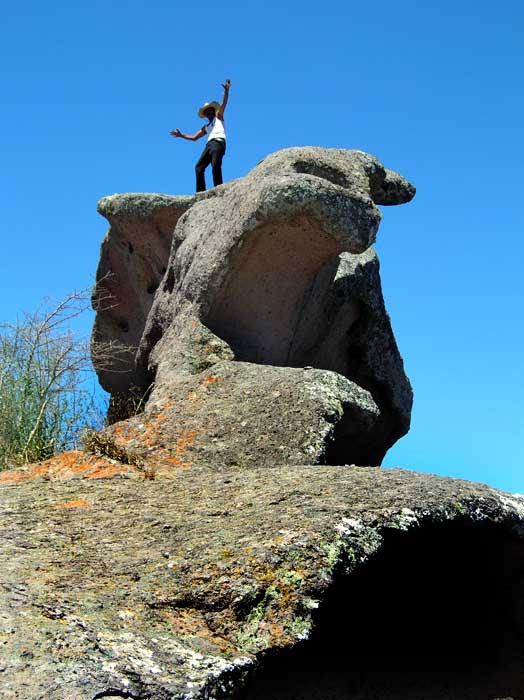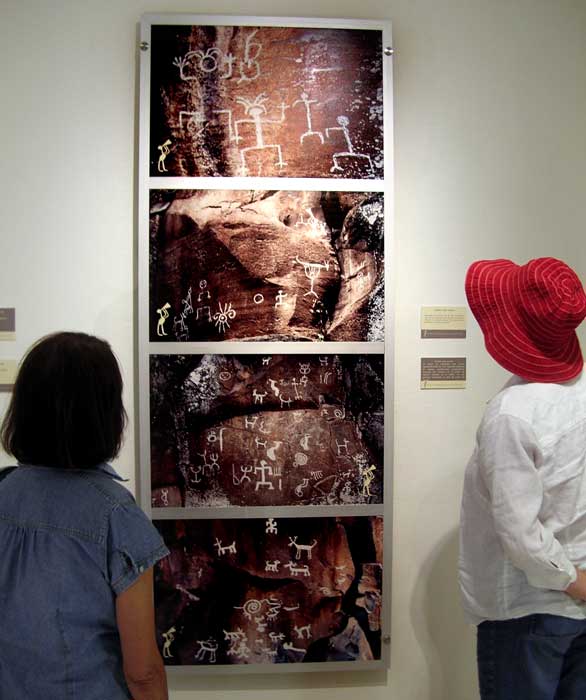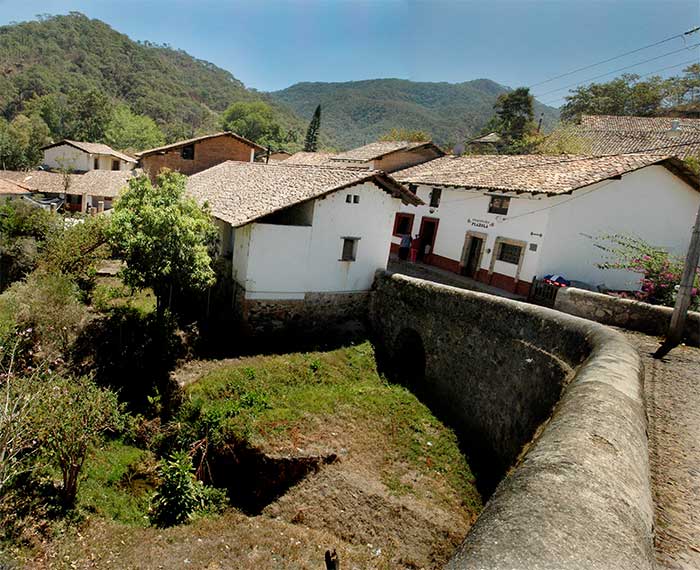The Psychedelic Bell, the New
Mascota Museum and Magical San Sebastián
By John Pint
April, 2012.
Mascota’s eminent archaeologist, Joseph Mountjoy recently informed us
that the town’s already outstanding museum has been completely upgraded
and expanded. We decided this was a perfect excuse to revisit Mascota,
which lies about 150 kilometers west of Guadalajara and Lake Chapala.
We also planned to take a peek at the nearby mountain village of San
Sebastián, whose charm is legendary.
Naturally, we could not imagine driving from Guadalajara to Mascota
without stopping at one of western Mexico’s most extraordinary natural
wonders, a little mountain called La Campana, also known as the
Psychedelic Bell because of its bizarre, wave-like formations.
We reached La Campana about two hours after leaving Guadalajara,
planning to hike up to its peak via the rather complicated route
described in our book Outdoors in Western Mexico. However, the first
thing we discovered was a brand-new iron gate just where you turn off
the highway. As we approached the gate we were hailed—in English—by a
friendly voice: “Do you want to visit La Campana?” The owner of the
voice was one Tino López, who introduced himself as the new owner of
the mountain. He also told us of a much quicker and easier way to get
on top of La Campana than the one we knew.
We parked our cars 50 meters past the gate, walked uphill another 50
meters and found ourselves on a footpath which led us to the curious
rock formations in a matter of minutes. “I’m always in the area,” says
Tino. “Just tell people to shout my name and I’ll be glad to guide
them,” he says. The walk to the top is 428 meters, one way, but note
that there are no railings to hold on to, so you must carefully watch
your step. It’s definitely not a hike for small children unless you’re
carrying them in your backpack.

Renovation of the museum cost about one million pesos and its doors
were officially reopened in August of 2011. It now has an auditorium, a
library and five large rooms where over 600 items are on display,
including petroglyphs, figurines and skeletons, many of which date back
as far as 800 B.C.
This museum is really a jewel. The petroglyphs alone are mind-boggling
and there’s a special display of an ancient patolli, a
Snakes-and-Ladders type game engraved on top of a flat, horizontal
rock. A guard showed us a copy of the Rules of Patolli as played by the
Tarascos of Angahuan, Michoacán, written up in 1941 by anthropologist
Pedro Carrasco. It involves throwing dice and moving four pieces around
the board, any of which can be “killed” if an opponent’s piece lands in
the same space. Ancient patolli players, it seems, would bet blankets,
jewelry or even their homes on the outcome of the game.

Many
new pieces have been added to the museum’s collection. I found
particularly interesting the curious wide, flat faces of “gingerbread
man” figurines which seem to be unique to this area. Most extraordinary
of all, I think, are several quartz pendants found in El Pantano.
Amazingly, these are beautifully faceted…and 2,800 years old, perhaps
the oldest faceted stones in the world.
We spent the night in
one of Mascota’s wonderful old Casonas and the next day took a quick
trip to San Sebastián del Oeste, a 45-kilometer drive from Mascota,
located east of the winding highway to Puerto Vallarta.
The road
to San Sebastián is now nicely asphalted but the streets of the little
town—now officially a Pueblo Mágico—are still paved with cobblestones
and utterly charming. Like so many of the Spaniards’ early settlements
in Western Mexico, San Sebastián, founded in 1605, developed near mines
which, all too often, were located atop the most rugged and
inhospitable peaks of the most remote and hard-to-reach mountains. In
the case of San Sebastián, there were 30 some mines producing gold,
silver, lead and zinc. The precious metals would eventually be carried
to Veracruz, from which, once a year, they were shipped to Spain. San
Sebastián became so prosperous that at one point it had a population of
20,000 and for a while was even the capital of the state of Jalisco.
The Revolution brought an end to the prosperity and today the town has
only 600 inhabitants and only one mine in operation.
Just
wandering the picturesque streets of San Sebastián is a pleasure in
itself. As we were traveling with archaeologists Rodrigo and Cynthia
Esparza we naturally visited the town’s little museum, a tour made
fascinating by its very articulate caretaker, Juan Aguirre. Because the
town is not far from Puerto Vallarta, it now has lots of little shops
making and selling arts, crafts and jewelry.

Visiting
these three wonderful sites made for a full and most enjoyable weekend.
If you want to do the same and plan to stay overnight in one of the
reasonably priced and gorgeous casonas, don’t forget to bring along a
mosquito net, a real necessity for sleeping in rural hotels. If you
don’t have one, you can create your own out of tulle (tul in Spanish),
that white stuff for making wedding veils. It’s available everywhere in
dressmaking and fabric shops. Get that net and you’ll be set for a
great weekend in and around Mascota.
How to get there
From
Guadalajara, take highway 15 towards Nogales and, just before the toll
road appears, bear left, following the signs for Ameca. Highway 70
takes you past Ameca and west to Mascota. If you live near Lake
Chapala, you can take highway 80 towards Barra de Navidad. After
Juchitlán, watch for a sign saying Ayutla. Turn right onto this road,
pass Ayutla and Cuautla and keep going northwest until you reach
Mascota. If you want to stop at La Campana, you’ll find it at 16.3
kilometers past Atenguillo (coming from Guadalajara) or about 30
kilometers past Cuautla if you’re coming from that way. The parking
spot for hiking up La Campana is at N20 22.247 W104 35.651. In Mascota,
the Casa de la Cultura is located one block east of the plaza. San
Sebastián is a 45-kilometer drive north from Mascota. Driving time from
Guadalajara to Mascota: about two and a half hours.
|